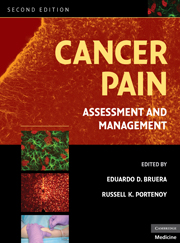Book contents
- Frontmatter
- Contents
- Contributors
- Preface
- SECTION I MECHANISMS AND EPIDEMIOLOGY
- SECTION II EPIDEMIOLOGY AND SYNDROMES
- SECTION III ASSESSMENT
- SECTION IV PHARMACOLOGICAL TREATMENT
- 9 Pharmacology of analgesia: basic principles
- 10 Pharmacogenetic considerations in the treatment of cancer pain
- 11 Pharmacology of opioid analgesia: clinical principles
- 12 Opioid side effects and management
- 13 Antipyretic analgesics
- 14 Adjuvant analgesic drugs
- 15 Neuraxial analgesia
- SECTION V OTHER INTERVENTIONAL STRATEGIES
- SECTION VI REHABILITATION AND PSYCHOLOGICAL INTERVENTIONS
- SECTION VII THE ROLE OF ANTINEOPLASTIC THERAPIES IN PAIN CONTROL
- SECTION VIII PAIN IN SPECIAL POPULATIONS
- SECTION IX DIFFICULT PAIN PROBLEMS
- SECTION X SYSTEMS OF CARE
- Index
- Plate section
- References
14 - Adjuvant analgesic drugs
from SECTION IV - PHARMACOLOGICAL TREATMENT
Published online by Cambridge University Press: 06 July 2010
- Frontmatter
- Contents
- Contributors
- Preface
- SECTION I MECHANISMS AND EPIDEMIOLOGY
- SECTION II EPIDEMIOLOGY AND SYNDROMES
- SECTION III ASSESSMENT
- SECTION IV PHARMACOLOGICAL TREATMENT
- 9 Pharmacology of analgesia: basic principles
- 10 Pharmacogenetic considerations in the treatment of cancer pain
- 11 Pharmacology of opioid analgesia: clinical principles
- 12 Opioid side effects and management
- 13 Antipyretic analgesics
- 14 Adjuvant analgesic drugs
- 15 Neuraxial analgesia
- SECTION V OTHER INTERVENTIONAL STRATEGIES
- SECTION VI REHABILITATION AND PSYCHOLOGICAL INTERVENTIONS
- SECTION VII THE ROLE OF ANTINEOPLASTIC THERAPIES IN PAIN CONTROL
- SECTION VIII PAIN IN SPECIAL POPULATIONS
- SECTION IX DIFFICULT PAIN PROBLEMS
- SECTION X SYSTEMS OF CARE
- Index
- Plate section
- References
Summary
Introduction
The term adjuvant analgesic was originally coined to refer to a small number of drugs that were commercialized for reasons other than pain but could be used as analgesics in selected circumstances. When these nontraditional analgesics were prescribed to cancer patients to supplement the analgesia provided by opioids, they were considered to be adjuvant to the mainstay therapy – hence the term. In recent years, the number, diversity, and conventional use of these nontraditional analgesics have increased dramatically. Several are now indicated and promoted for specific types of noncancer pain and many are used as first-line therapies in varied populations. Accordingly, the term adjuvant analgesic is now a commonly applied misnomer and refers to a large and diverse group of drugs that have an expanding role in pain medicine.
In the management of cancer pain, the term adjuvant analgesic also must be distinguished from other labels, specifically adjuvant drug and co-analgesic. According to the three-step analgesic ladder model of cancer pain pharmacotherapy developed under the auspices of the World Health Organization in the mid-1980s, adjuvant drugs comprise both analgesics used to supplement opioid therapy (adjuvant analgesics) and drugs used to manage the side effects of the opioids. Given this dual labeling, the drugs intended to provide analgesia are best denoted by the more specific term adjuvant analgesics. The label co-analgesic has been used synonymously with adjuvant analgesic in the cancer treatment setting and also could be used whenever referring to a drug added for analgesic purposes to an existing opioid regimen.
- Type
- Chapter
- Information
- Cancer PainAssessment and Management, pp. 272 - 286Publisher: Cambridge University PressPrint publication year: 2009



